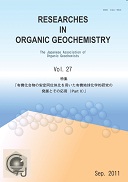Volume 27
Displaying 1-16 of 16 articles from this issue
- |<
- <
- 1
- >
- >|
SPECIAL ISSUE "Advances in molecular and stable isotope studies among the organic geochemical and related communities (Part II)"
-
Article type: Article
2011Volume 27 Pages 1-
Published: September 30, 2011
Released on J-STAGE: April 13, 2017
Download PDF (654K)
Review
-
Article type: Article
2011Volume 27 Pages 3-11
Published: September 30, 2011
Released on J-STAGE: April 13, 2017
Download PDF (694K) -
Article type: Article
2011Volume 27 Pages 13-21
Published: September 30, 2011
Released on J-STAGE: April 13, 2017
Download PDF (529K) -
Article type: Article
2011Volume 27 Pages 23-32
Published: September 30, 2011
Released on J-STAGE: April 13, 2017
Download PDF (832K) -
Article type: Article
2011Volume 27 Pages 33-43
Published: September 30, 2011
Released on J-STAGE: April 13, 2017
Download PDF (2930K) -
Article type: Article
2011Volume 27 Pages 45-54
Published: September 30, 2011
Released on J-STAGE: April 13, 2017
Download PDF (654K) -
Article type: Article
2011Volume 27 Pages 55-72
Published: September 30, 2011
Released on J-STAGE: April 13, 2017
Download PDF (711K)
Article
-
Article type: Article
2011Volume 27 Pages 73-79
Published: September 30, 2011
Released on J-STAGE: April 13, 2017
Download PDF (205K) -
Article type: Article
2011Volume 27 Pages 81-89
Published: September 30, 2011
Released on J-STAGE: April 13, 2017
Download PDF (480K) -
Article type: Article
2011Volume 27 Pages 91-95
Published: September 30, 2011
Released on J-STAGE: April 13, 2017
Download PDF (379K) -
Article type: Article
2011Volume 27 Pages 97-102
Published: September 30, 2011
Released on J-STAGE: April 13, 2017
Download PDF (354K)
REGULAR
Review
-
Article type: Article
2011Volume 27 Pages 103-115
Published: September 30, 2011
Released on J-STAGE: April 13, 2017
Download PDF (553K)
Article
-
Article type: Article
2011Volume 27 Pages 117-127
Published: September 30, 2011
Released on J-STAGE: April 13, 2017
Download PDF (1134K) -
Article type: Article
2011Volume 27 Pages 129-142
Published: September 30, 2011
Released on J-STAGE: April 13, 2017
Download PDF (843K)
Technical paper
-
Article type: Article
2011Volume 27 Pages 143-148
Published: September 30, 2011
Released on J-STAGE: April 13, 2017
Download PDF (631K) -
Article type: Article
2011Volume 27 Pages 149-154
Published: September 30, 2011
Released on J-STAGE: April 13, 2017
Download PDF (752K)
- |<
- <
- 1
- >
- >|
